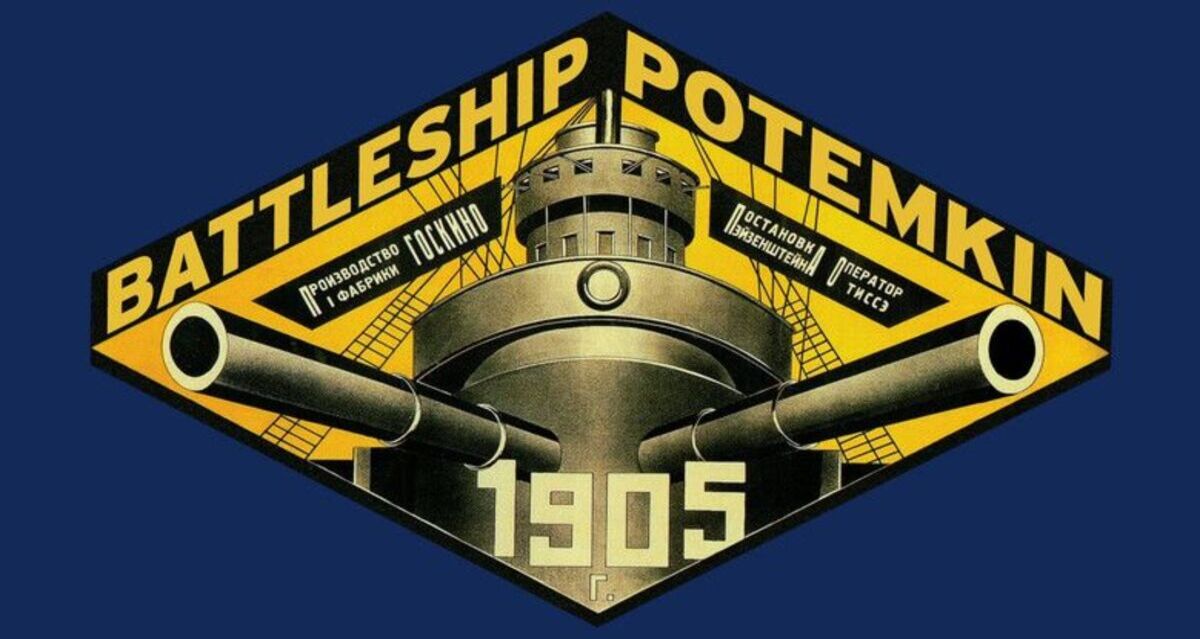
Battleship Potemkin is a landmark film directed by Sergei Eisenstein and released in 1925. It is considered one of the greatest achievements in the history of cinema and has had a profound influence on the art form. This silent film is a powerful portrayal of the 1905 uprising in Russia, which started on the battleship Potemkin. The film’s revolutionary storytelling techniques, innovative editing, and powerful imagery have made it a cornerstone of film theory and a touchstone for generations of filmmakers. In this article, we will explore 45 fascinating facts about Battleship Potemkin, shedding light on its production, impact, and legacy in the world of cinema. So, grab your popcorn and get ready to dive into the fascinating world of Battleship Potemkin!
Key Takeaways:
- Battleship Potemkin” is a groundbreaking film that used powerful storytelling techniques to inspire change and challenge authority, making it a timeless and influential piece of cinema history.
- The movie’s impact on the art of filmmaking is immeasurable, influencing editing techniques and storytelling methods, and inspiring future filmmakers like Alfred Hitchcock and Orson Welles.
Fact #1
The movie Battleship Potemkin is a 1925 Soviet silent film directed by Sergei Eisenstein.
Fact #2
Battleship Potemkin is considered one of the most influential propaganda films in the history of cinema.
Fact #3
The movie is based on true events that occurred during the 1905 Russian Revolution, specifically the mutiny aboard the battleship Potemkin.
Fact #4
Battleship Potemkin was initially met with controversy and faced censorship in several countries due to its revolutionary themes.
Fact #5
The film was praised for its groundbreaking cinematic techniques, including Eisenstein’s use of montage to evoke powerful emotions in the audience.
Fact #6
Battleship Potemkin was one of the first films to employ the “Odessa Steps” sequence, which has since become an iconic and frequently referenced scene in cinema history.
Fact #7
The film’s score was composed by Edmund Meisel and is known for its intense and dramatic musical accompaniment.
Fact #8
Battleship Potemkin has been included in numerous lists of the greatest films of all time.
Fact #9
The film’s cinematography, by Eduard Tisse, was celebrated for its innovative camera angles and composition.
Fact #10
Battleship Potemkin was not initially well-received by the Soviet authorities, as they deemed it too radical and potentially dangerous.
Fact #11
The movie’s release was delayed multiple times due to censorship concerns and political pressures.
Fact #12
Battleship Potemkin was eventually released in a heavily censored version, but its impact was still felt worldwide.
Fact #13
The film was instrumental in popularizing the concept of montage as an effective storytelling technique.
Fact #14
Battleship Potemkin showcased the power of cinema to inspire political change and challenge authority.
Fact #15
The film’s depiction of the working class rising against oppression resonated with audiences around the world.
Fact #16
Battleship Potemkin greatly influenced future filmmakers, including Alfred Hitchcock and Orson Welles.
Fact #17
The film’s impact and lasting legacy can still be seen in contemporary cinema, with filmmakers paying homage to its techniques and themes.
Fact #18
Battleship Potemkin was banned in several countries, including Nazi Germany and the United States, due to its revolutionary content.
Fact #19
The film’s release in the United States was met with resistance from conservative groups who feared its potential to incite unrest.
Fact #20
Battleship Potemkin was eventually released in its original form in the United States in the 1960s, to critical acclaim.
Fact #21
The film’s title refers to the battleship Potemkin, which played a central role in the mutiny against the oppressive Tsarist regime.
Fact #22
Battleship Potemkin employs a nonlinear narrative structure, jumping between different events of the Russian Revolution.
Fact #23
The film’s iconic “Odessa Steps” sequence showcases the brutal and violent response of the authorities to the rebellious sailors.
Fact #24
Battleship Potemkin was highly praised for its performances, particularly that of Aleksandr Antonov as the leading character, Grigory Vakulinchuk.
Fact #25
The film’s visual symbolism and imagery are powerful and thought-provoking, adding depth to its political message.
Fact #26
Battleship Potemkin has been studied and analyzed in film schools around the world, becoming a cornerstone of film theory.
Fact #27
The movie’s impact on the art of filmmaking is immeasurable, influencing the development of editing techniques and storytelling methods.
Fact #28
Battleship Potemkin received numerous accolades and awards, solidifying its status as a cinematic masterpiece.
Fact #29
The film’s revolutionary themes and portrayal of the struggle against oppression continue to resonate with audiences today.
Fact #30
Battleship Potemkin is often hailed as Eisenstein’s most significant and enduring work.
Fact #31
The movie’s impact reached beyond the realm of cinema, inspiring revolutions and uprisings in various parts of the world.
Fact #32
Battleship Potemkin was a trailblazer in terms of its use of visual storytelling to convey political messages.
Fact #33
The film’s success and critical acclaim helped establish Eisenstein as one of the greatest filmmakers of his time.
Fact #34
Battleship Potemkin has been digitally restored and preserved to ensure its accessibility for future generations.
Fact #35
The film’s impact on the Soviet film industry was substantial, encouraging a new wave of politically charged and socially conscious cinema.
Fact #36
Battleship Potemkin continues to be screened at film festivals and retrospective events, captivating audiences with its timeless storytelling.
Fact #37
The film’s powerful imagery and emotional resonance have made it a cultural touchstone in the realm of political cinema.
Fact #38
Battleship Potemkin remains an influential and relevant film, reminding us of the power of cinema as a force for social change.
Fact #39
The movie’s impact on the development of film editing techniques cannot be overstated, with Eisenstein’s innovative approach still studied and admired today.
Fact #40
Battleship Potemkin was initially intended to be a part of a larger film project called “October,” which would have depicted the entire Russian Revolution.
Fact #41
The film’s release in the Soviet Union was delayed due to concerns that it may incite further turmoil during a period of political instability.
Fact #42
Battleship Potemkin was eventually released with a new musical score composed by Dimitri Shostakovich in 1968.
Fact #43
The film’s impact on the development of Soviet cinema cannot be overstated, as it inspired a new wave of filmmakers to explore politically charged subjects.
Fact #44
Battleship Potemkin is a testament to the power of cinema to inform, educate, and inspire change in society.
Fact #45
The movie’s enduring legacy is a testament to its artistic and political importance, solidifying its place in the history of cinema.
Conclusion
In conclusion, “Battleship Potemkin” stands as a timeless masterpiece in the world of cinema. Its revolutionary techniques, powerful storytelling, and significant historical impact have cemented its place in the annals of film history. From its daring portrayal of a mutiny aboard a Russian battleship to its influential use of montage editing, the movie continues to inspire filmmakers and captivate audiences around the globe. Whether you are a film enthusiast or simply curious about the history of cinema, “Battleship Potemkin” is a must-watch for its artistic brilliance and its ability to provoke thought and discussion. So, grab your popcorn, dim the lights, and prepare to embark on an unforgettable cinematic journey.
FAQs
1. What is the significance of “Battleship Potemkin” in film history?
Battleship Potemkin” is considered one of the most influential films in history due to its innovative use of montage editing and its powerful portrayal of social and political unrest. It paved the way for a new era in filmmaking and inspired generations of filmmakers.
2. How accurate is the historical depiction in “Battleship Potemkin”?
While “Battleship Potemkin” is based on true events, it does take some creative liberties for dramatic purposes. It captures the essence of the mutiny aboard the battleship, but specific details and characters may have been altered or fictionalized.
3. Can I appreciate “Battleship Potemkin” even if I’m not familiar with Russian history?
Absolutely! While some knowledge of Russian history can enhance your understanding of the film’s context, “Battleship Potemkin” stands on its own as a cinematic masterpiece. Its themes of oppression, rebellion, and the power of collective action resonate universally.
4. Is “Battleship Potemkin” still relevant today?
Definitely. The film’s themes of social inequality, government oppression, and the fight for justice are timeless and continue to be relevant in contemporary society. Its impact on filmmaking techniques also reverberates in modern cinema.
5. How can I watch “Battleship Potemkin”?
“Battleship Potemkin” is widely available on various platforms. You can rent or purchase the film on popular streaming services or buy a DVD or Blu-ray copy. It is also occasionally screened in theaters or film festivals, so keep an eye out for special screenings in your area.
Battleship Potemkin, a cinematic masterpiece, continues to inspire filmmakers and audiences alike. Its groundbreaking techniques and powerful storytelling have left an indelible mark on the world of cinema. For those fascinated by the early days of filmmaking, exploring the captivating lives of silent movie stars offers a glimpse into a bygone era. Equally compelling is the opportunity to delve into 39 facts about Eisenstein's influential film October Ten Days That Shook the World, which further showcases the director's visionary style and impact on the art form.
Was this page helpful?
Our commitment to delivering trustworthy and engaging content is at the heart of what we do. Each fact on our site is contributed by real users like you, bringing a wealth of diverse insights and information. To ensure the highest standards of accuracy and reliability, our dedicated editors meticulously review each submission. This process guarantees that the facts we share are not only fascinating but also credible. Trust in our commitment to quality and authenticity as you explore and learn with us.


